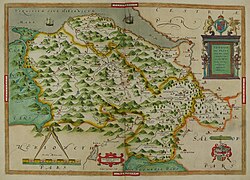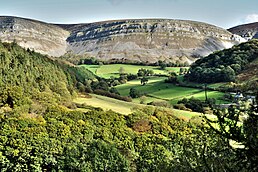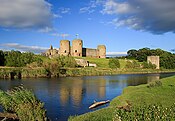Denbighshire
This article's lead section contains information that is not included elsewhere in the article. (October 2023) |
Denbighshire
Sir Ddinbych (Welsh) | ||
|---|---|---|
| ||
|
NUTS 3 code UKL13 | | |
| ONS code | 00NG | |
| Website | www.denbighshire.gov.uk | |

Denbighshire (/ˈdɛnbiʃər, -ʃɪər/ DEN-bee-shər, -sheer;[1] Welsh: Sir Ddinbych [ˌsiːr ˈðɪnbɨχ]) is a county in the north-east of Wales. It borders the Irish Sea to the north, Flintshire to the east, Wrexham to the southeast, Powys to the south, and Gwynedd and Conwy to the west. Rhyl is the largest town, and Ruthin is the administrative centre. Its borders differ from the historic county of the same name.
Denbighshire has an area of 326 square miles (840 km2) and a population of 95,800, making it sparsely populated. The most populous area is the coast, where Rhyl (25,149) and Prestatyn (19,085) form a single built-up area with a population of 46,267. The next-largest towns are Denbigh (8,986), Ruthin (5,461), and Rhuddlan (3,709). St Asaph (3,355) is a city. All of these settlements are in the northern half of the county; the south is even less densely populated, and the only towns are Corwen and Llangollen (3,658).
The geography of Denbighshire is defined by the broad valley of the River Clwyd, which is surrounded by rolling hills on all sides except the north, where it reaches the coast. The Vale of Clwyd, the lower valley, is given over to crops, while cattle and sheep graze the uplands. The Clwydian Range in the east is part of the Clwydian Range and Dee Valley Area of Outstanding Natural Beauty.

This part of Wales contains the country's oldest known evidence of habitation – Pontnewydd (Bontnewydd-Llanelwy) Palaeolithic site has Neanderthal remains of some 225,000 years ago. The county is also home to several medieval castles, including Castell Dinas Brân, Denbigh, and Rhuddlan, as well as St Asaph Cathedral. Llangollen International Musical Eisteddfod takes place in the town each July.[2]
Formation
The main area was formed on 1 April 1996 under the
Other principal areas including part of historical Denbighshire are
Early history
Researchers have found signs that Denbighshire was inhabited at least 225,000 years ago.
Archaeology
In 2021 February, archaeologists from Aeon Archaeology announced a discovery of over 300 Stone Age tools and artifacts in Rhuddlan. They revealed scrapers, microliths, flakes of chert (a hard, fine-grained, sedimentary rock composed of microcrystalline or cryptocrystalline quartz), flints and other rudimentary tools. An expert, Richard Cooke, believes the lithic remains belonged to ancient peoples, who while passing through the area, made camp by the river more than 9,000 years ago.[5][6]
Geography
- See also List of places in Denbighshire.
The eastern edge of Denbighshire follows the ridge of the
Rhyl and Prestatyn form a single built-up area in the north of the county, with a population of 46,267. They are immediately adjacent to the Kinmel Bay and Abergele built-up area in neighbouring Conwy, and at the eastern end of series of coastal resorts which that also includes Colwyn Bay and Llandudno further west.
Population
According to the 2021 United Kingdom census, Denbighshire's population was approximately 95,800.[9] According to previous censuses, the population of Denbighshire was 93,734 in 2011 and 93,065 in 2001.[10] The largest towns on the coast are Rhyl (2001 population c. 25,000) and Prestatyn (2001 population c. 18,000). According to the 2011 Census returns, 24.6 per cent stated they could speak Welsh.[11]
Economy
Since the 20th-century demise of the coal and steel industries in the
The upland areas with their sheep farms and small, stone-walled fields are attractive to visitors. Redundant farm buildings are often converted into self-catering accommodation, while many farmhouses supply bed and breakfast. The travel trade began with the arrival of the coast railway in the mid-19th century, opening up the area to
Transport
The
There are no motorways in Denbighshire. The
There are local bus services between the main towns. Several services by Arriva Buses Wales run along the main coast road between Chester and Holyhead, linking the coastal resorts. Another route links Rhyl to Denbigh.[19]
Politics
Denbighshire is represented in the House of Commons by three MPs. The Welsh Labour Party lost to the Welsh Conservatives in the 2019 general election for the first time.[20]
The following MPs were elected from Denbighshire in 2019:
- Simon Baynes (Welsh Conservatives) in Clwyd South, first elected in 2019.[21]
- David Jones (Welsh Conservatives) in Clwyd West, first elected in 2005.[22]
- James Davies (Welsh Conservatives) in Vale of Clwyd, first elected in 2019.[23]
Denbighshire is also represented in the
- Clwyd South, first elected in 2011[24]
- Clwyd West, first elected in 2007[25]
- Vale of Clwyd, first elected in 2021.[26]
In 2019, research by UnHerd in association with the pollster FocalData showed that most people across the county support the British monarchy.[27]
See also
- Denbighshire (historic)
- List of Lord Lieutenants of Denbighshire
- List of Custodes Rotulorum of Denbighshire
- List of High Sheriffs of Denbighshire
- Denbighshire (UK Parliament constituency)
- List of places in Denbighshire
- List of schools in Denbighshire
References
- ISBN 978-0-521-15255-6.
- ^ "Attractions in Clwyd". Britain Express. Retrieved 21 April 2016.
- ^ a b "Local Government (Wales) Act 1994". The National Archives. legislation,gov.uk. Retrieved 1 May 2016.
- ^ "Pontnewydd Cave". University of Central Lancashire. Retrieved 1 May 2016.
- ^ "Hundreds of stone age tools found on Denbighshire housing site". BBC News. 17 February 2021. Retrieved 15 June 2021.
- ^ "Encampment dating back 9,000 years has been discovered in Rhuddlan". Denbighshire Free Press. 17 February 2021. Retrieved 15 June 2021.
- ^ ISBN 0-540-05278-7.
- ^ "Clwydian Range". North East Wales. Archived from the original on 19 April 2014. Retrieved 30 April 2016.
- ^ Evans, Harri (28 June 2022). "The population of North Wales has dropped in the last decade". North Wales Live. Retrieved 3 December 2022.
- ^ "Local Authority population 2011". Archived from the original on 22 May 2015. Retrieved 22 May 2015.
- ^ "Welsh speakers by local authority, gender and detailed age groups, 2011 Census". Stat Wales. Archived from the original on 9 May 2016. Retrieved 1 May 2016.
- ^ "Clwyd". NFU Cymru. 5 December 2014. Archived from the original on 20 March 2016. Retrieved 1 May 2016.
- ISBN 978-0-241-97024-9.
- ISBN 978-1-317-12709-3.
- ISBN 978-0-08-097040-0.
- ^ "Six projects to kick-start the North Wales economy in 2016". Daily Post. 1 January 2016. Retrieved 1 May 2016.
- ^ "Crewe to Holyhead". North Wales Coast Railway. 2012. Retrieved 30 April 2016.
- ISBN 978-0-7495-7743-8.
- ^ "Discover the towns of Wales". Arriva Wales. Arriva Buses Wales. Retrieved 30 April 2016.
- ^ "General Election 2019: Tories win overall majority as Labour suffer in North Wales". Denbighshire Free Press. Retrieved 14 December 2019.
- ^ "Clwyd South parliamentary constituency – Election 2019". Retrieved 14 December 2019.
- ^ "Clwyd West parliamentary constituency – Election 2019". Retrieved 14 December 2019.
- ^ "Vale of Clwyd parliamentary constituency – Election 2019". Retrieved 14 December 2019.
- ^ "Clwyd South – Welsh Assembly constituency – Election 2016". Retrieved 14 December 2019.
- ^ "Clwyd West – Welsh Assembly constituency – Election 2016". Retrieved 14 December 2019.
- ^ "Vale of Clwyd – Welsh Assembly constituency – Election 2021". Retrieved 26 May 2021.
- ^ "People in Denbighshire still back the monarchy". Denbighshire Free Press. 29 November 2019. Retrieved 14 December 2019.
External links
- . Encyclopædia Britannica. Vol. 8 (11th ed.). 1911. p. 18.
- Denbighshire at Curlie
- Denbighshire landscape




